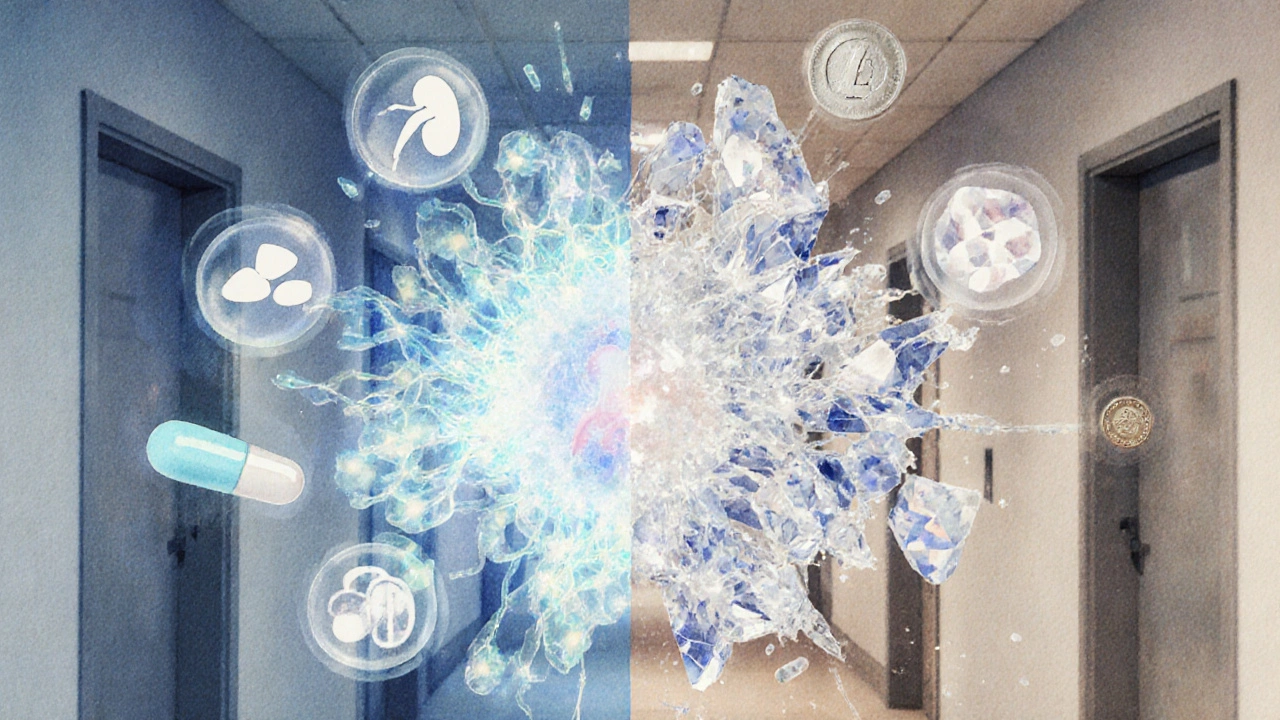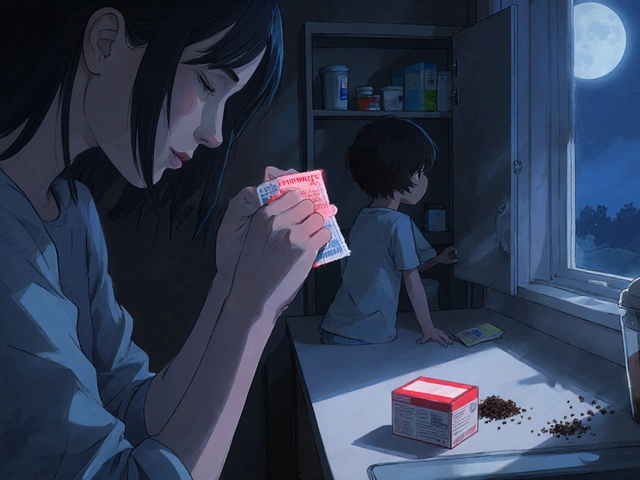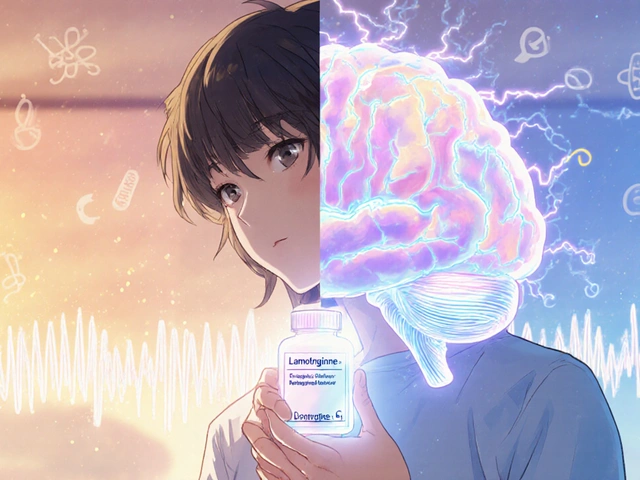Phosphate Binder Selector
Select Patient Factors
Reason:
Renagel (sevelamer) is a non‑calcium phosphate binder used to control hyperphosphatemia in patients with chronic kidney disease on dialysis. It works by binding dietary phosphate in the gut, preventing its absorption. Because it contains no calcium, it avoids the extra calcium load that can accelerate vascular calcification, a major concern for dialysis patients.
Why phosphate binders matter in chronic kidney disease
Chronic kidney disease (CKD) is a progressive loss of kidney function that impairs phosphate excretion, leading to hyperphosphatemia. Elevated serum phosphate drives secondary hyperparathyroidism and contributes to coronary artery calcification, increasing cardiovascular mortality. Managing phosphate is therefore a cornerstone of the KDOQI guidelines (Kidney Disease Outcomes Quality Initiative), which recommend keeping phosphate within the normal range using diet, dialysis, and binders.
How Renagel (sevelamer) works
Sevelamer is a polymer of polyallylamine that carries positive charges. In the acidic environment of the stomach it binds phosphate anions, forming an insoluble complex that passes unchanged through the intestines. The drug is available as powder that patients mix with water or juice.
Key attributes:
- Mechanism: electrostatic binding of phosphate; also binds bile acids, modestly lowering LDL‑C.
- Formulation: carbonate or hydrochloride salt; carbonate is more common in the U.S.
- Typical dose: 800mg three times daily with meals, titrated to serum phosphate targets.
- Side‑effects: gastrointestinal upset (bloating, constipation), metabolic acidosis (more with hydrochloride).
- Cost: higher than calcium‑based binders; insurance coverage varies.
Common alternatives to Renagel
Clinicians often weigh Renagel against several other binders, each with distinct pros and cons.
Lanthanum carbonate is a chewable tablet that binds phosphate via a metal‑oxide mechanism, providing high binding efficiency with low tablet burden.
Calcium acetate supplies calcium while binding phosphate, making it inexpensive and widely used in resource‑limited settings.
Ferric citrate is an iron‑based binder that also improves iron stores, beneficial for patients with anemia of CKD.
Magnesium carbonate adds magnesium to the phosphate‑binding repertoire, useful when patients need additional magnesium supplementation.
Other, less common options include nicotinamide (which reduces intestinal phosphate transport) and calcium carbonate, though the latter carries a higher risk of calcium overload.
Head‑to‑head comparison
| Binder | Mechanism | Calcium load | Typical dose (mg per day) | Notable side effects | Typical cost (US$)‡ |
|---|---|---|---|---|---|
| Renagel (sevelamer) | Polymer‑phosphate electrostatic binding | None | 2,400‑4,800 | GI upset, metabolic acidosis (HCl) | ≈$200‑$250 per month |
| Lanthanum carbonate | Metal‑oxide binding | None | 1,500‑3,000 | Constipation, rare lanthanum deposition | ≈$150‑$180 per month |
| Calcium acetate | Calcium‑phosphate precipitation | High (up to 1,500mg Ca) | 2,250‑4,500 | Hypercalcemia, vascular calcification | ≈$30‑$50 per month |
| Ferric citrate | Iron‑phosphate complex | None | 1,500‑3,000 (as elemental Fe) | Dark stools, iron overload (rare) | ≈$120‑$150 per month |
| Magnesium carbonate | Magnesium‑phosphate precipitation | Low‑moderate | 2,000‑3,500 | Diarrhea, hypermagnesemia | ≈$25‑$40 per month |
‡ Costs are approximate average wholesale prices in the United States (2025). Insurance formularies and regional pricing can shift these numbers substantially.

Decision factors for clinicians
Choosing the right binder isn’t just about price. Below are the most common “jobs to be done” when selecting a therapy.
- Minimize calcium load. Patients with existing vascular calcification or high serum calcium should avoid calcium acetate or carbonate. Renagel, lanthanum, and ferric citrate fit this need.
- Control LDL‑C. Sevelamer’s bile‑acid binding modestly lowers LDL, making it attractive for patients with dyslipidemia.
- Address anemia. Ferric citrate can serve dual purpose by providing iron, reducing need for separate iron supplements.
- Reduce pill burden. Lanthanum’s chewable tablets (often once or twice daily) may improve adherence compared with multiple daily powders of sevelamer.
- Budget constraints. Calcium acetate remains the cheapest, but the risk of calcium overload may negate cost savings in high‑risk patients.
- GI tolerance. Some patients cannot tolerate the powder of sevelamer; magnesium carbonate may cause diarrhea, while lanthanum is usually well tolerated.
Practical tips for prescribing
- Start low and titrate: begin with 800mg sevelamer carbonate with each main meal; reassess phosphate in 2‑4 weeks.
- Monitor calcium, phosphorus, and PTH at each dialysis visit; adjust binder dose accordingly.
- Watch for metabolic acidosis if using the hydrochloride salt; consider switching to the carbonate form.
- Educate patients on mixing the powder thoroughly; incomplete dissolution can reduce binding efficiency.
- Check insurance formulary before writing the prescription; if sevelamer is a high‑tier drug, document the clinical rationale (e.g., hypercalcemia risk) to improve prior‑auth approval.
Related concepts and future directions
The choice of binder sits within a broader management plan that includes diet, dialysis prescription, and control of secondary hyperparathyroidism. Emerging therapies such as nicotinamide aim to lower intestinal phosphate transport without adding mineral load, but large‑scale outcome data are still pending.
Guidelines continue to evolve. The 2024 update from the National Kidney Foundation emphasizes individualized binder selection based on calcium balance, cardiovascular risk, and patient‑reported outcomes.
Bottom line
Renagel (sevelamer) remains the go‑to non‑calcium binder for patients where calcium overload is a red flag, especially when LDL‑C reduction adds value. Lanthanum offers a low‑pill‑count alternative with comparable efficacy. Calcium acetate stays relevant for low‑budget settings but demands vigilant calcium monitoring. Ferric citrate shines when iron deficiency co‑exists, while magnesium carbonate is a niche option for magnesium‑deficient patients.
Frequently Asked Questions
Can I take Renagel with other phosphate binders?
Mixing binders is generally discouraged because it can alter the binding capacity of each agent and increase GI side‑effects. If a single binder fails to reach target phosphate, clinicians usually switch agents rather than stack them, unless a short‑term overlap is medically justified.
Is sevelamer safe for pediatric dialysis patients?
Pediatric dosing follows the same weight‑adjusted principles as adults. Studies up to 2023 show comparable efficacy and tolerability, but careful monitoring for growth parameters and calcium balance is essential.
How does sevelamer affect LDL cholesterol?
Sevelamer binds bile acids in the gut, prompting the liver to convert more cholesterol into bile. Clinical trials report an average 10‑15% reduction in LDL‑C after 12 weeks of therapy, making it a dual‑action drug for many dialysis patients.
What laboratory values should I track while a patient is on Renagel?
Key labs include serum phosphate, calcium, intact PTH, bicarbonate (to catch acidosis), and lipid panel if LDL‑C lowering is a goal. Check these at each dialysis session for the first month, then monthly once stable.
Why might a patient develop constipation on sevelamer?
The polymer matrix can thicken intestinal contents, especially when mixed with low‑fluid drinks. Advising patients to hydrate well and possibly adding a stool softener can alleviate the problem.
Is ferric citrate covered by Medicare?
As of 2025, ferric citrate has a specific HCPCS code and is generally covered for dialysis patients with documented iron deficiency or hyperphosphatemia, but prior‑auth criteria vary by plan.
Should I avoid calcium binders if a patient has low bone density?
Low bone density itself isn’t a contraindication, but excess calcium can exacerbate vascular calcification, which indirectly harms bone health. In such cases, non‑calcium binders like sevelamer or lanthanum are preferred.






Reviews
It is unconscionable that patients are forced to choose between life‑saving medication and financial ruin.
When you peel back the layers, the binder choice is really a meditation on trade‑offs: cost, calcium load, and even the humble LDL‑C. It reminds us that medicine is as much philosophy as science.
Oh great, another spreadsheet of pills. Sevelamer sounds like a sci‑fi villain, but it actually just hangs phosphate out to dry. If you like powdery drama, go ahead, otherwise chewable lanthanum is the real MVP.
I appreciate the thorough breakdown. For patients who dread swallowing dozens of pills, the chewable tablets of lanthanum can be a sigh of relief. On the flip side, the powder of sevelamer can be a hassle if mixing isn’t done right. Bottom line: match the binder to the patient’s lifestyle.
Totally agree with the lifestyle point. I’ve seen people skip doses just because the powder clumps.
Let’s not forget the silver lining – sevelamer’s LDL‑C reduction can be a real game‑changer for heart health. If insurance covers it, it’s worth the extra effort. Stay positive, folks!
Exactly! A little extra motivation can keep patients on track. Maybe suggest a tasty juice mix for the powder.
Grammar matters: use “binders” not “binder’s”. Keep sentences short.
From a pharmacoeconomic standpoint, the decision matrix for phosphate binders is nuanced and multifactorial. First, the absence of calcium in sevelamer eliminates the risk of iatrogenic hypercalcemia, a concern especially pertinent in patients with underlying vascular calcification. Second, the lipid‑lowering effect of sevelamer, mediated through bile‑acid sequestration, offers a modest but clinically relevant reduction in LDL‑C, thereby potentially attenuating atherosclerotic progression. Third, the dosage flexibility of sevelamer (800 mg to 4.8 g daily) permits titration to individual phosphorus targets without imposing a fixed pill burden. Fourth, gastrointestinal tolerability remains a drawback; patients frequently report bloating, constipation, or, in rare cases, metabolic acidosis when using the hydrochloride formulation. Fifth, the cost differential is stark: sevelamer’s monthly price hovers around $200‑$250, far exceeding calcium‑based alternatives, which can be procured for under $50 per month. Sixth, insurance coverage varies; prior‑authorization often mandates documentation of calcium overload or dyslipidemia as justification. Seventh, adherence patterns correlate strongly with formulation acceptability; the powder requires diligent mixing, whereas lanthanum’s chewable tablets may foster better compliance. Eighth, for patients with concurrent iron deficiency, ferric citrate presents a dual therapeutic benefit, albeit with its own risk profile of dark stools and possible iron overload. Ninth, magnesium carbonate provides a niche option for those needing supplemental magnesium, though diarrhea is a frequent side effect. Tenth, emerging therapies such as nicotinamide aim to modulate intestinal phosphate transport without adding mineral load, yet robust outcome data are pending. Eleventh, the 2024 KDIGO update emphasizes individualized binder selection based on calcium balance, cardiovascular risk, and patient‑reported outcomes. Twelfth, regular monitoring of serum phosphate, calcium, PTH, bicarbonate, and lipid panels is essential to gauge efficacy and safety. Thirteenth, patient education on proper mixing techniques for powder formulations cannot be overstated; incomplete dissolution compromises binding efficiency. Fourteenth, clinicians should consider the totality of patient comorbidities, socioeconomic status, and personal preferences when prescribing. Finally, the overarching goal remains clear: maintain serum phosphate within target range while minimizing adverse effects and preserving quality of life.
Your empathy shines through when you mention the daily struggle of mixing powders. A splash of fruit juice can turn a dreaded chore into a bright moment. Keep supporting patients, they need that kindness.
People think big pharma is benevolent but they profit from our confusion. The secret is that binders are a cash cow for insurers. Stay vigilant
Drama alert: imagine a world where every dialysis patient fights a silent enemy called phosphate. The battle is fierce, the stakes are life‑or‑death, and the hero? A tiny pill or powder that can tip the scales.
And the real plot twist? Big pharma and the government collude to keep us in the dark. Wake up, people!